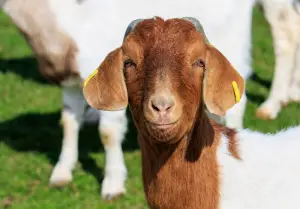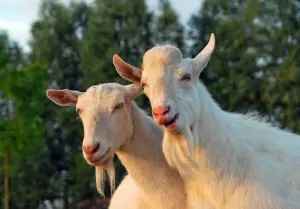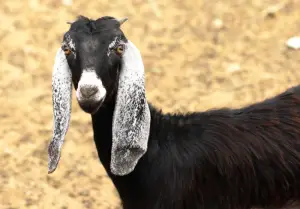Profitable Goat Breeds
While goats can make great pets, they can also be highly profitable in both the meat and dairy industries. If you’re interested in raising goats and making money in the process, you’ll need to know how to profit from your herd of goats.
What are the most profitable goat breeds? Here are the most profitable goat breeds depending on the commodity you plan to sell:
Most Profitable Meat Goats:
- Boer
- Kiko
- Myotonic (Fainting Goat)
- Pygmy
Most Profitable Dairy Goats:
- Saanen
- Nigerian Dwarf
- French Alpine
- LaMancha
Most Profitable Dual-Purpose Goats
- Anglo-Nubian
- Kinder
In addition to selecting the right breed for your operation, you will want to run your business in a way to maximize your profits. Read on to learn more about these profitable goat breeds and how to get the most out of your herd.
Top Profitable Goat Breeds To Own
Profitable Meat Goat Breeds 
Raising goats for meat is a low-risk, high-yield business model, making it attractive for beginners. If you have decided to raise goats for meat, you will want to choose a breed known for its quality of meat and fast growth rate.
#1 Meat Goat Breed: Boer
The Boer is the largest of goat breeds, with bucks reaching up to 300 pounds at maturity. Boers are also the most common breed of goat in the United States due to their success as a meat-producing goat. They grow rapidly and are typically ready to process between 3 and 5 months of age or between 50 and 80 pounds. Boers also have a high fertility rate and are prolific breeders.
#2 Meat Goat Breed: Kiko
The Kiko is a good choice of meat goat if you are looking to sell pasture-raised meat. Kikos have the ability to quickly gain substantial weight on pasture alone, which has the potential to save farmers significantly in feed. Kikos are also well-known for birthing and raising multiple kids (baby goats) each pregnancy.
#3 Meat Goat Breed: Myotonic (Fainting Goat)
Myotonics, otherwise known as Tennessee Fainting Goats, are often used in crossbreeding programs due to their muscle-heavy compositions. The gene that allows them to gain muscle more readily than other breeds is the same that causes their muscles to lock when they are startled – causing them to become briefly immobile and fall over or “faint.”
#4 Meat Goat Breed: Pygmy
Pygmy goats are stocky with heavy bones and are bred primarily for meat. They are smaller than most other meat goats, with bucks at most 60 pounds, but their manageable size makes them ideal for smaller homesteads and smaller (i.e., child) handlers.
Profitable Dairy Goat Breeds: 
If you are interested in raising dairy goats, you will want a breed of goat that is both a prolific breeder and a high-yield milk producer. As an additional advantage, dairy goats should be docile and tame, as they will need to cooperate with their handlers multiple times per day when being milked.
#1 Dairy Goat Breed: Saanen
The Saanen produces more milk than any other breed of goat – up to three gallons of milk per day – making it one of the most profitable of dairy breeds. Saanens reach up to 150 pounds at maturity, making them a medium-large breed.
#2 Dairy Goat Breed: Nigerian Dwarf
As their name suggests, Nigerian Dwarfs are small in stature – topping out at about 75 pounds. Does yield around two quarts, or ½ gallon, of milk per day. They are especially gentle and friendly, making them a popular breed of choice for 4H and FFA programs.
#3 Dairy Goat Breed: French Alpine
French Alpine goats produce around 1 gallon of milk per day, making them a profitable dairy breed to raise. They weigh 150-200 pounds at maturity and does have large udders – making them easier on the hands when milking.
#4 Dairy Goat Breed: LaMancha
LaMancha goats produce ⅔ – ¾ gallons of milk per day, putting them in the middle of the French Alpine and the Nigerian Dwarf in terms of daily milk production. LaManchas are a hardy, resilient breed with distinguishable small ears.
Profitable Dual-Purpose Goat Breeds: 
Can’t decide whether to raise dairy goats or meat goats? There are productive dual-purpose breeds that provide both ample milk and high-quality meat. These will not only allow you to profit from the meat and milk that they provide but will also allow you to sell the kids – marketing them as the perfect all-in-one goats for self-sufficient homesteaders.
#1 Dual-Purpose Goat Breed: Anglo-Nubian
While the Nubian does not yield as much milk as other popular dairy breeds, they are known for their high percentage of butterfat, making them a good choice for producing dairy products. They have a mature weight of between 135 and 175 pounds, and because they are a large breed of goat, they are known to grow quickly when compared to other breeds.
#2 Dual-Purpose Goat Breed: Kinder
Kinder goats produce a large quantity of milk – up to a gallon per day – and are known for their sweet (non-goaty) tasting milk and high butterfat percentage. If they didn’t produce a profitable carcass as well, we would have listed them with the rest of the dairy goats above. Kinders mature to a weight between 120 and 150 pounds and grow quickly, making them a good choice for meat as well.
Which Is More Profitable: Goat Meat Or Goat Milk?
At the end of the day, dairy goats are more profitable. But raising dairy goats is not for the faint of heart for a few reasons:
- They are more time-intensive. Dairy goats should be milked every 12 hours. Dairy chores are time-consuming, and they make it challenging to take a vacation or just a weekend away.
- There is more start-up cost. Unless you are milking your goats with your hands and a bucket, you will need to invest in expensive equipment. You will also need sterile containers to store the milk and a way to process and house the milk.
- Selling dairy products comes with strict rules and licensing requirements. Dairy products are heavily regulated in the United States, and meeting the many requirements to legally sell your milk can be daunting.
Meat goats are much easier to care for. As long as the goat’s basic needs are met, you can turn them out to pasture in the morning and go about your regular day (or leave them pastured without bringing them in at night, so long as they are safe and sheltered).
Which commodity you decide to produce will depend largely on your lifestyle and available initial investment. If you decide to try your hand at both dairy and meat, there are dual-purpose breeds that will work well for that kind of operation, and as an added bonus, your family will be self-sufficient in terms of both meat and dairy products.
Maximizing Your Goat Profits
While it would be unrealistic to expect to turn a profit immediately, there are things you can do right away to make your business more lucrative in the long run. There are several ways you can maximize profits from your goat business.
- Choose the right breed. Some goat breeds have been bred over many years to reach a marketable weight in a relatively short time frame. Others have been bred over the years to produce high quantities of milk for a longer period of time. Whatever your business model, make sure to choose the appropriate breed for your operation.
- Choose your feed carefully. The largest expense you will incur will be feed. This is especially important for dairy operations, as your goats may have different dietary needs. If you have enough quality pasture to free-range your goats, this will save you significantly. If you don’t, you will want to do your homework in sourcing the highest quality feed for the best price in your area.
- Market your goat products. Because there is currently more demand in the US for goat products than there is supply, you should find it easy to find a market for your meat or milk. To maximize profits, find the most profitable market in your locale for your product. This may be at auction, or it may be as a vendor for a local restaurant.
- Protect your goats. Goats are prey animals, and humans aren’t the only species that eat them. To protect your investment, you will need to protect your animals from predators. The easiest way to do this is through the use of an electric fence. This will help keep the predators out of the goat pen and the goats inside their enclosure, where they are safe.
Which Goat Breed Are You Going To Raise For A Profit?
Because of the relatively low supply when compared to demand, as well as the increasing demand for both goat meat and goat dairy products, you should be able to bring in a profit regardless of whether you decide to raise meat goats or dairy goats. If you choose one of the breeds in this article, you will be off to a great start.
You can learn more about owning and raising homestead animals in my latest articles here!
